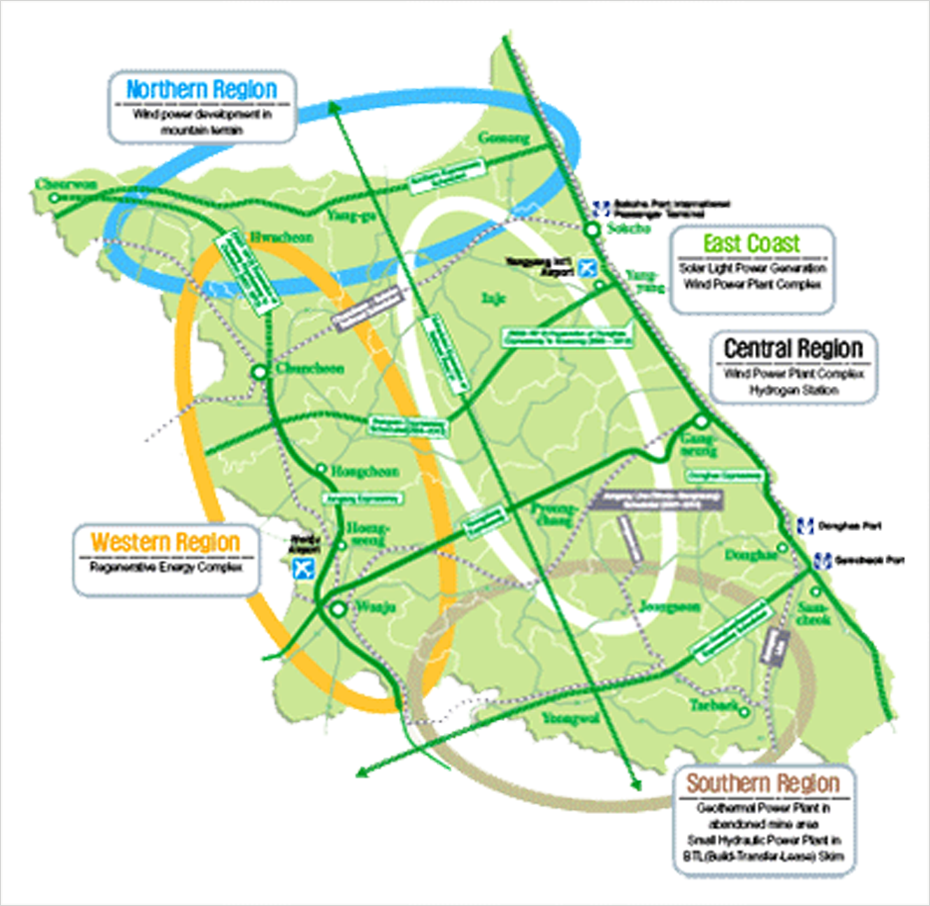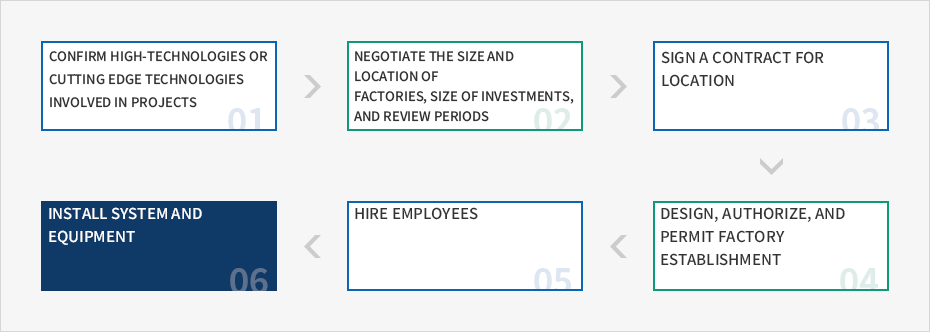New and Renewable Energy
- Home
- Business Opportunities
- New and Renewable Energy
Global Competition and Korea’s Economic Status Mandates the Use of Regenerative Energy for Companies in Korea
Korea’s Rapid Economic Growth and Ever-increasing Demand for Energy
- Korea has placed a significant importance on market-mechanism, as shown in recent efforts to eliminate economic inefficiency by adopting global standards on corporate, labor, public service, and financial sectors.
- McKinsey and many other economic institutes predict that Korea would advance into the level of developed countries by sustaining 5 to 6% of annual economic growth, with per capita income reaching USD 30,000 by 2010.
- Korea's economic growth requires constant demand for energy. However uncertainties around global energy environment, heavy reliance on overseas market, and UN Framework Convention on Climate Change challenges Korea to make significant breakthroughs in her fossil dependent energy policy.
Korea's Energy Policy and Implementation Strategy
- Korea has shifted its energy policy from government-centered to market-oriented. Since Korea envisions achieving 'Sustainable Growth', its policy is oriented to encourage development and use of regenerative energy by focusing on technology development and competent financial support skim for commercial development of regenerative energy.
Korea's Regenerative Energy Development Policy
Present Situation
- Only 1.24% of entire energy consumption in Korea is supplied by regenerative energy. Policy direction for regenerative energy development
- Cross-ministry' government policy annually established and updated for purpose of developing regenerative energy.
- Policy to enhance consumer trust through introduction of regenerative energy facility certification system.
- Policy to gain durability, trust, and standardization in technological expertise for regenerative energy by operation of pilot research complex as well as test center for regenerative energy.
- Policy to pre-purchase regenerative energy and partially pay the gap between the regenerative energy's selling price and production cost.
- Financing plan for spreading regenerative energy, i.e. tax rate cut on construction of regenerative energy facility, capital support for R&D, further tariff reduction for regenerative energy related imports.
Regenerative Energy Valley Strategy of Gangwon-do
Gangwon is a Natural Fit
- Gangwon-Do, with the best wind power resources in Korea, has highly advantageous condition in developing the Province into wind power generation hub in Korea.
- In accordance with UNFCCC, obligation to reduce greenhouse gas emission is taking effect in force. As for some developed countries, a minimum of 5~8% reduction in greenhouse gas emissions is to be completed from the year 2008 to 2012, compared to the amount of those back in 1990. Korean government is now in its way to develop regenerative energy in preparation for the emission reduction
requirements, which are expected to be imposed from the year 2013.
- Drastic increase in regenerative energy production is forecasted.
Development Strategy
- Establishment of Regenerative Energy Valley
- Target Investment: USD 700 million through the year 2015
- Increase in share of Regenerative energy from the current 2.86% of total energy consumption to 10.19% in ten years
- Develop geothermal and wind power as two major regenerative energy sources in Gangwon
- Focus on Infrastructure, i.e. building R&D center, training geothermal professionals
- Efforts to promote geothermal energy industry, i.e. attracting core-parts manufacturers
Roadmap for Regenerative Energy: Centered on Geothermal and Wind Power
- Two main pillars for regenerative energy: geothermal and wind power
- Infrastructure: Kick-off of R&D center coupled with academic institution on the two energy sources in Gangwon National University and Samcheok National University.
- Geothermal industry development: construction of manufacturing base for core-parts in geothermal power generation facility
East Coast / Western Region
Development Concept
- East Coast Region: solar light power generation complex, research hub for low-speed wind power generation
- Western Region: regenerative energy complex, i.e. geothermal
Implementation Strategy
- Prohibit any use of fossil fuel in supplying social welfare facility with energy: Use only Regenerative energy sources for such facility in Gangwon.
- Develop solar light energy complexes in East Coast, where tourist attractions are abundant.
- Develop geothermal energy as the second biggest source of regenerative energy. Since Gangwon Province has many natural hot springs in the East Coast, geothermal energy development in this region is reasonable choice for the province.
- Support networking of researchers in regenerative energy field. For example, Gangwon Provincial Government played key role in launching of Korean chapter of International Geothermal Heap Pump Association (IGHPA) within the territory of the province.
Central Region and Northern Region
Main Concept
- Central Region- Clustering for wind power generation and industrialization of windpower generation facility
- Northern Region- Wind power generation complex along mountainous areas borderedwith de-militarized zone (peaceful utilization of DMZ)
Implementation Strategy
- Wind power generation clustering: power generation complex coupled withindustrialization of wind power generation facility
- Wind Resource Measurement
- Wind Map drawing for Foreign and Domestic Investment Promotion
- Establish a wind power certification center within the pilot operation center for the windpower, which Gangwon-Do plans to catapult to the world-class certification institution
Central Region
Main Concept
Power Park with emphasis on Hydrogen-StationImplementation Strategy
Offer Free Lease of land for Hydrogen-Station, most important R&D infrastructurefor hydrogen storage technology development.Southern Region
Concept of Development
Power Park with emphasis on Hydrogen-StationDevelopment Strategy
- all Hydraulic Power: BTL(Build-Transfer-Lease)
- Bio-Mass- Develop bio-mass power: plants and supply hot waters from the plant to local households.
- Bio-Mass- Develop bio-mass power: Generated electricity will be used in the region first, and remaining will be sold to electricity market.

Two main pillars for regenerative energy: geothermal and wind power
Infrastructure: Kick-off of R&D center coupled with academic institution on the two energy sources in Gangwon National University and Samcheok National University.
Geothermal industry development: construction of manufacturing base for core-parts in geothermal power generation facility

Supports & Incentives
Major Investment Project
- Wind power development
- Present Status of Wind Power Resources and Enterprise Propulsion Plan
| Regions | Measurement | Measurement Result | Promoted Situation | |
|---|---|---|---|---|
| Period | Average Wind Speed (m/sec) | Energy Density (w/㎡) | ||
| DaeGwanRyung Observation Platform | Sep.,00~Nov. 01 | 9.7 | 1,212 | Gangwon Wind Power Generation Co. 2.0MW X 49 Unit |
| Hoengseong County, Mount TaeGi | Sep.,00~Nov. 01 | 6.3 | 397 | Gangwon Province |
| TaeBaek City, Mount HamBaek | Sep.,00~Nov. 01 | 7.7 | 465 | GE+Posco 1.5MW X 30 Unit |
| TaeBaek City, Mt. MaeBong | Mar.,01~Jul.,02 | 8.4 | 746 | Taebaek City 0.85MW X 8 Unit |
| TaeBaek City, PeeJae | Mar.,01~Jul.,02 | 5.4 | 250 | |
| TaeBaek City, GweNeMi | Nov.,03~Apr.04 | 9.4 | KOSPO (2.0MW X 10 Unit) | |
| PyoungChang District YookBaekMaJeeGi | Aug.,04~Sep.,05 | 6.2 | KOSPO (2.0MW X 10 Unit) | |
| YangGu District DolSanRyoung | Nov.,03~Apr.04 | 9.5 | KOSPO (2.0MW X 10 Unit) | |
Development of Geothermal Complex
- Mandatory installation of regenerative energy facility according to the Act for Development and Use of Regenerative Energy.
※ Mandatory usage of regenerative energy: Government financed organizations shall install regenerative energy facility for 5%of total construction cost for buildings over 3000㎡. - Demand escalation is expected for Temperature Conditioning System using Geothermal and Solar Light Energy.
- Geothermal Power Generation requires the use of Heat Pump, which Korea have to rely on Imports.
Tax Benefits (for businesses in high-tech industries)
- National Tax: Corporate and income taxes are 100% exempted for the first five years and reduced by 50% for the next two years.
- Regional Tax: Acquisition and registration taxes are 100% exempted. Aggregate land and property taxes are 100% exempted for the first 15 years.
- Tariff, special consumption tax, and value-added tax are 100% exempted on capital goods imported for three years after submission of the report of investment.
- Investments worth USD 1 million or more in advanced-tech qualified industries are eligible for a reduction in land rent and taxes.
Subsidies
Employment Subsidy
- The subsidy is provided for a (manufacturing) company with a foreign stake of 30% or more or a foreign investor as the largest shareholder.
- It is provided to all new Korean recruits employed as regular full-time workers if ten or more are hired at the same time.
- A monthly subsidy of USD 500 per eligible person is provided for up to three years.
Education/Training Subsidy
- The subsidy is provided for a (manufacturing) company with a foreign stake of 30% or more or a foreign investor as the largest shareholder.
- It is provided to all new Korean recruits employed as regular full-time workers if ten or more are hired at the same time.
- A monthly subsidy of up to USD 500 per eligible person is provided for up to six months.
